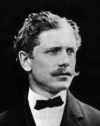 During October, 1971, four cesium atomic beam clocks were flown on regularly scheduled commercial jet flights around the world twice, once eastward and once westward, to test Einstein's theory of relativity with macroscopic clocks. From the actual flight paths of each trip, the theory predicted that the flying clocks, compared with reference clocks at the U.S. Naval Observatory, should have lost 40+/-23 nanoseconds during the eastward trip and should have gained 275+/-21 nanoseconds during the westward trip ...
During October, 1971, four cesium atomic beam clocks were flown on regularly scheduled commercial jet flights around the world twice, once eastward and once westward, to test Einstein's theory of relativity with macroscopic clocks. From the actual flight paths of each trip, the theory predicted that the flying clocks, compared with reference clocks at the U.S. Naval Observatory, should have lost 40+/-23 nanoseconds during the eastward trip and should have gained 275+/-21 nanoseconds during the westward trip ...Relative to the atomic time scale of the U.S. Naval Observatory, the flying clocks lost 59+/-10 nanoseconds during the eastward trip and gained 273+/-7 nanosecond during the westward trip, where the errors are the corresponding standard deviations. These results provide an unambiguous empirical resolution of the famous clock "paradox" with macroscopic clocks.





1 comment:
Actually this makes sense, for example where I work in Viagra Online labs the boss maintenance and cleaning seth all the clocks right every week, because no every clock it's the same in everywhere and deppending of the position and what it's next the clock can alterate the system and make it goes slowly or faster.
Thanks, nice post.
Post a Comment